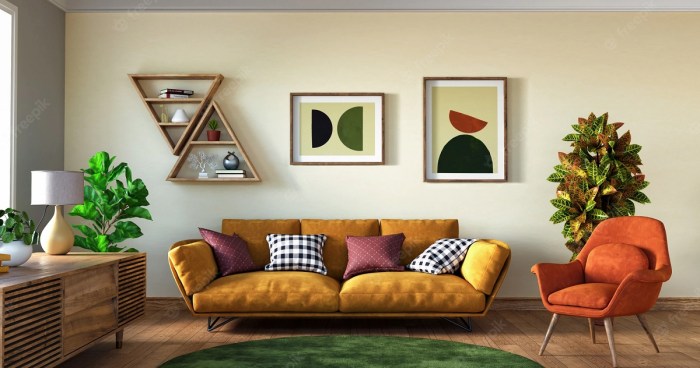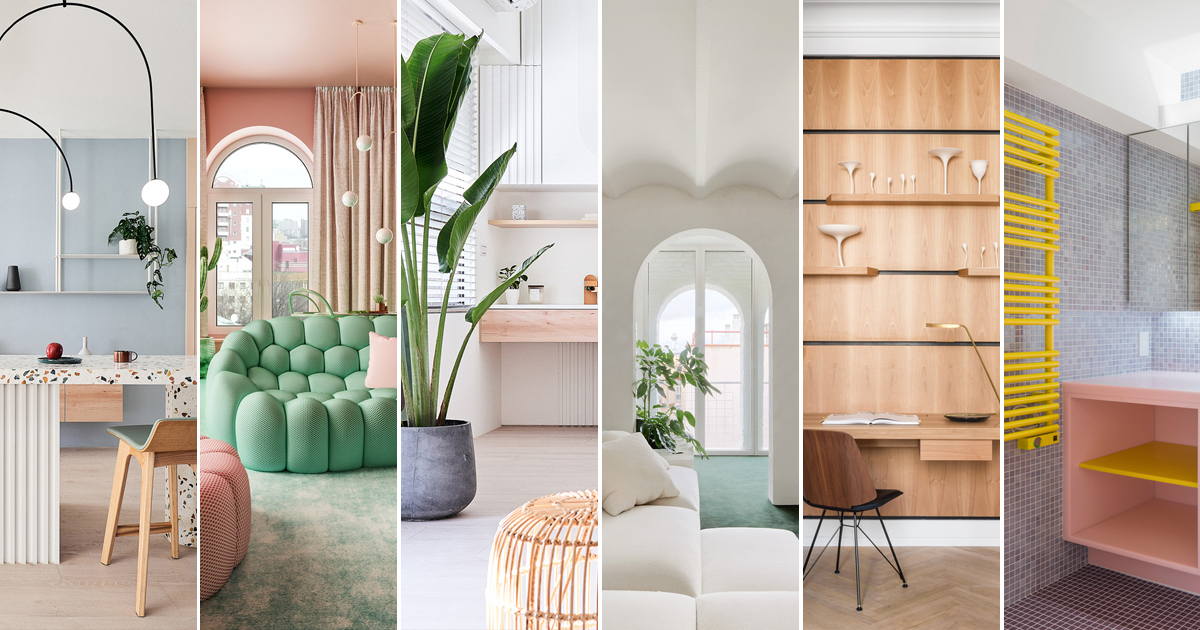Popular Materials & Textures in 2025 Home Accessory Design
Trending accessories for 2025 home design – The home accessory market in 2025 will see a significant shift towards sustainable and ethically sourced materials, coupled with a diverse range of textures that add depth and visual interest to interior spaces. This section explores the predicted dominant materials and textural trends, highlighting the contrast between natural and synthetic options.
Predicted Dominant Materials
Sustainable wood, specifically reclaimed and responsibly harvested varieties, will remain a popular choice, offering both beauty and environmental consciousness. Recycled metals, such as aluminum and copper, will also feature prominently, reflecting a growing commitment to circular economy principles. Innovative textiles, crafted from recycled fibers or plant-based alternatives like Tencel or organic cotton, will gain traction, aligning with the increasing demand for eco-friendly products. These materials promise durability and aesthetic appeal, resonating with consumers seeking both style and sustainability.
Key Textural Trends
Textural contrasts will be a defining feature of 2025 home accessory design. Smooth, polished surfaces will coexist with rough, textured finishes, creating a dynamic interplay of tactile experiences. Matte finishes will offer a sophisticated, understated elegance, while glossy surfaces will provide pops of vibrant color and reflective light. This balance between contrasting textures will add visual depth and complexity to interior spaces.
Natural vs. Synthetic Materials

While natural materials like sustainable wood and organic cotton will dominate, synthetic materials will still find their place, particularly those made from recycled or bio-based sources. The key difference lies in the ethical and environmental considerations. Consumers are increasingly discerning, prioritizing accessories made from sustainably harvested or recycled materials over those with a significant environmental footprint. This preference is driving innovation in the development of eco-friendly synthetic alternatives.
Examples of Materials and Textural Trends
| Material | Texture | Example Accessory | Sustainability Note |
|---|---|---|---|
| Reclaimed Wood | Rough, Textured | Wooden Tray | Reduces deforestation |
| Recycled Aluminum | Smooth, Polished | Desk Organizer | Reduces waste |
| Organic Cotton | Soft, Slightly Textured | Throw Pillow | Reduces pesticide use |
| Recycled Glass | Smooth, Glossy | Vases | Reduces landfill waste |
Color Palettes & Trends for 2025 Home Accessories
The color palettes shaping 2025 home accessory design will reflect a desire for both tranquility and vibrancy. A range of palettes, from earthy neutrals to bold jewel tones, will cater to diverse tastes and interior styles.
Influential Color Palettes
Three key color palettes are expected to dominate: Earthy Neutrals (warm browns, creams, and muted greens), Vibrant Jewel Tones (deep blues, emeralds, and rich purples), and Soft Pastels (muted pinks, lavenders, and light blues). Each palette evokes a distinct mood and aesthetic, seamlessly integrating with various interior design styles.
Palette Descriptions and Interactions
Earthy Neutrals create a calming, nature-inspired ambiance, perfect for minimalist or Scandinavian styles. Vibrant Jewel Tones inject energy and sophistication, complementing eclectic or maximalist designs. Soft Pastels foster a sense of serenity and romance, ideal for traditional or shabby chic interiors. These palettes can be blended or used independently to achieve a desired atmosphere.
Visual Representation of Palettes
Imagine the Earthy Neutrals palette as a warm sunset, with creamy beige transitioning to deep brown, accented by sage green. The Vibrant Jewel Tones palette is a rich tapestry of sapphire blue, emerald green, and amethyst purple, creating a luxurious and dramatic effect. The Soft Pastels palette is a gentle whisper of blush pink, lavender, and sky blue, evoking a sense of airy lightness.
Shapes & Forms in Trending 2025 Home Accessories
The shapes and forms of 2025 home accessories will showcase a blend of geometric precision and organic fluidity, reflecting a balance between minimalist and maximalist aesthetics. This section examines the prominent shapes and their impact on both aesthetic appeal and functionality.
Prominent Shapes and Forms
Geometric shapes like circles, squares, and triangles will maintain their popularity, offering clean lines and structured designs. Organic forms, inspired by nature, will also be prominent, incorporating curves, flowing lines, and asymmetrical designs. This fusion of geometric and organic shapes will create a dynamic and visually engaging range of accessories.
Impact on Aesthetics and Functionality
Geometric shapes contribute to a sense of order and modernity, while organic forms introduce a touch of warmth and natural beauty. The interplay of these shapes influences the overall aesthetic, creating a balance between structure and fluidity. Functionality is also impacted; for example, curved forms can enhance ergonomics, while geometric shapes can maximize space efficiency.
Minimalist vs. Maximalist Forms
Minimalist designs will favor simple, clean lines and single geometric shapes. Maximalist designs will embrace a more complex interplay of shapes and textures, layering geometric and organic forms for a richer visual experience. Both approaches have their own appeal, depending on the desired aesthetic and overall interior design scheme.
Categorization of Shapes and Forms
Biophilic design will incorporate natural forms such as leaves, branches, and flowing lines. Geometric design will feature precise shapes such as cubes, spheres, and cones. Abstract designs will explore unconventional shapes and forms, pushing the boundaries of traditional aesthetics. These categories highlight the diverse range of design principles shaping 2025 accessory trends.
Sustainable & Ethical Considerations in 2025 Home Accessory Design
Sustainability and ethical sourcing are no longer niche concerns but rather central pillars of the home accessory market. Consumers are increasingly demanding transparency and accountability from brands, driving a significant shift towards eco-conscious practices.
Growing Importance of Sustainability and Ethical Sourcing
The growing awareness of environmental issues and social responsibility is pushing manufacturers to prioritize sustainable materials and ethical labor practices. Consumers are actively seeking out accessories made from recycled or sustainably harvested materials, supporting brands committed to minimizing their environmental impact and ensuring fair working conditions.
Sustainable Materials and Manufacturing Processes
Sustainable materials like recycled wood, bamboo, and organic cotton are gaining popularity. Manufacturing processes are also evolving, with a focus on reducing waste, minimizing energy consumption, and using non-toxic materials. This shift towards responsible production is essential for creating a more sustainable future for the home accessory industry.
Impact of Consumer Demand
The increasing consumer demand for sustainable and ethically produced accessories is driving innovation and competition within the industry. Brands are responding by investing in sustainable materials, improving manufacturing processes, and increasing transparency about their supply chains. This consumer-driven change is shaping a more responsible and sustainable market.
Incorporating Eco-Friendly Design Choices, Trending accessories for 2025 home design
Eco-friendly design choices can be incorporated into various accessory types. For example, using recycled materials in the production of lamps, choosing organic cotton for textiles, or employing energy-efficient lighting in smart home accessories. These small changes collectively contribute to a significant reduction in the environmental impact of home accessories.
Technological Integration in 2025 Home Accessories: Trending Accessories For 2025 Home Design
Technology is increasingly integrated into home accessories, blurring the lines between functionality and aesthetics. This section explores examples of this integration, highlighting both the benefits and drawbacks.
Examples of Technological Integration
Smart lighting systems offer customizable ambiance and energy efficiency. Voice-activated controls allow for hands-free operation of various accessories, enhancing convenience. Sensors integrated into accessories can automate tasks and provide valuable data. These examples showcase the expanding role of technology in shaping the home accessory landscape.
Benefits and Drawbacks of Technological Integration
Benefits include increased convenience, energy efficiency, and enhanced functionality. Drawbacks include potential privacy concerns, reliance on technology, and the added cost of tech-integrated accessories. Careful consideration of these factors is crucial when choosing tech-integrated accessories.
Traditional vs. Tech-Integrated Accessories
Traditional accessories offer simplicity and a timeless aesthetic, free from the complexities of technology. Tech-integrated accessories provide enhanced functionality and convenience but may require a learning curve and ongoing maintenance. The choice depends on individual preferences and priorities.
Potential Future Technological Advancements
Future advancements may include AI-powered personalization, augmented reality integration, and bio-integrated sensors. These advancements could lead to highly personalized and responsive home accessories, further blurring the lines between technology and design.
Emerging Styles & Trends for 2025 Home Accessories
Several emerging styles will significantly influence 2025 home accessory trends, reflecting a diverse range of aesthetic preferences and cultural influences. This section identifies and describes these styles.
Emerging Styles

Three key styles are anticipated: Neo-Vintage (a modern interpretation of classic designs), Global Fusion (blending elements from different cultures), and Biophilic Design (incorporating natural elements and textures). Each style offers a unique aesthetic, allowing for personalized expression and diverse design choices.
Style Descriptions and Interactions

Neo-Vintage accessories reinterpret classic designs with a contemporary twist, blending traditional aesthetics with modern materials and techniques. Global Fusion accessories seamlessly blend elements from various cultures, creating a rich and eclectic aesthetic. Biophilic design emphasizes natural materials, textures, and forms, fostering a connection between the interior space and the natural world. These styles can be mixed and matched to create unique and personalized interior spaces.
Key Characteristics of Emerging Styles
- Neo-Vintage:
- Reimagined classic designs
- Use of modern materials
- Blending of old and new aesthetics
- Global Fusion:
- Blending of cultural elements
- Diverse patterns and colors
- Eclectic and vibrant aesthetic
- Biophilic Design:
- Natural materials and textures
- Organic forms and shapes
- Connection to nature
Final Conclusion
In conclusion, the future of home accessories in 2025 points towards a harmonious blend of sustainability, technological advancement, and timeless aesthetics. The predicted trends highlight a growing consumer consciousness regarding ethical sourcing and environmental impact, while simultaneously embracing innovative materials and designs. By understanding these key developments, designers and homeowners can curate spaces that are both stylish and reflective of a responsible and forward-thinking approach to home décor.
